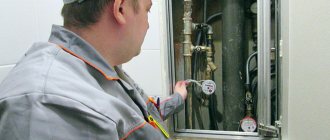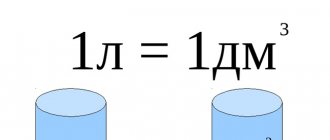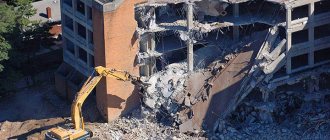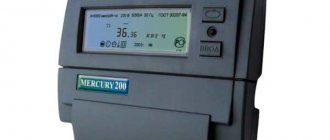To live comfortably in an apartment or private house, a person needs to have water in the plumbing networks with certain temperature limits. This allows you to satisfy all generally accepted sanitary standards for personal hygiene procedures and sanitary needs. The temperature of the tap water depends on the type of water supply and climatic factors. There are several types of technical solutions that allow maintaining the recommended temperature parameters in water intake systems.
The temperature of the water in the tap depends on climatic conditions, the depth of the water supply system, the location of water intake, and so on.
Accepted standards
A modern home provides cold and hot water to satisfy all needs. The temperature of cold water in the tap has regulations and can fluctuate between 5-15°C. Temperature limit values depend on factors such as:
- climatic conditions;
- depth of water supply systems;
- temperature in the technical underground (basement communication networks);
- place of water intake by water supply networks (rivers, canals, reservoirs, underground sources).

In order to check the water temperature, you need to use a special device that can be attached to the tap.
The temperature of cold water rises in the warm season and decreases in the cold season. This statement is valid for typical water supply schemes for water utilities, when it is taken from canal systems and reservoirs. Since the water surface warms up in summer, the amount of heat in the water masses changes accordingly. In the case of water supply from underground sources, the temperature regime remains almost constant throughout the year, due to the constant temperature in the underground water layers.
The amount of heat in water from cold water supply networks does not have a decisive impact on the creation of comfortable conditions in the sanitary and domestic sphere. Any housing requires a parallel supply of hot water, and the necessary heat is achieved by mixing.
Sanitary standards regulate the temperature of hot water in centralized hot water supply networks within 60-75°C. A deviation at night from 00.00 to 5.00 is allowed by 5°C and from 5.00 to 00.00 by 3°C. These standards are based on maintaining the specified values by boiler houses or central heating points (CHS). The calculated figures are based on the characteristics of boiler rooms and heat exchangers of central heating stations and allow them to comply with the standards of microbiological indicators in hot water pipes. Drinking water is supplied only through cold water supply networks.
What is the temperature of the cold water in the tap?
The temperature of hot water depends on both the type of water supply system and the time of day. At night, a temperature drop of 2 degrees lower than during the day is permissible. Temperature standards Standards for all indicators in the apartment must comply with SanPiN (sanitary rules and regulations) and GOSTs. SanPiN regulations for hot water have not changed in 2020.
These standards are adopted for reasons of expediency, since too cold or hot water can harm human health. Citizens pay not only for water delivery, but also for amenities associated with a certain temperature.
The water temperature directly depends on the type of water supply. Simply, cold and hot water must be at a certain temperature.
The hot water temperature should be 60-75 degrees (not higher than 60°C and not lower than 75 degrees). This temperature is required for all water points.
Disadvantages of hot water supply
In practice, the described temperature standards are not always maintained. This is due to a significant increase in the price of natural resources (gas, coal, fuel oil), which are used as fuel in boiler houses. Old-style boiler houses were designed to supply heat and hot water to hundreds of apartment buildings. Boilers have low efficiency, heating mains become unusable. Modern saving standards require switching to the creation of mini-boiler houses.
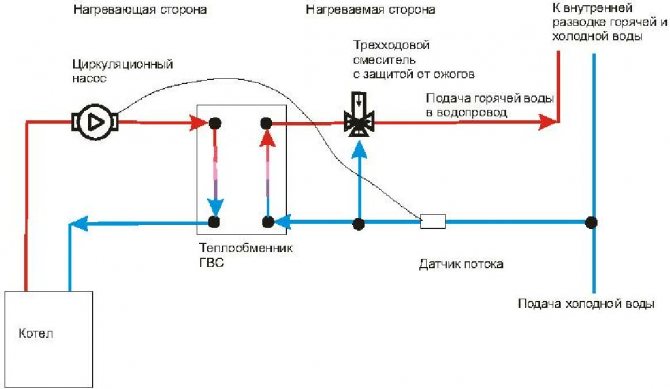
Built-in DHW circuits.
One of the aspects of unsatisfactory hot water supply is uneven temperature conditions. That is, the water in the tap does not become hot immediately; its temperature rises as it passes through the system. This is due to the facts of dismantling circulating plumbing systems in apartment buildings, due to their deterioration and due to heat savings by heat generating companies.
Such moments lead to the selection of an increased volume of water, which, given the high price for supplied hot water, is impractical. DHW utility networks use a specially prepared water reserve, to which various softening agents are added. It cannot be used as drinking water.
The consumer prefers DHW supply conditions in which hot water from the tap should be available year-round. Due to ongoing repairs and frequent emergencies, it is almost impossible to achieve these conditions.
Temperature of cold water in the tap according to SNIP standard 2020
These sanitary rules are mandatory for all legal entities and individual entrepreneurs whose activities are related to the organization and (or) provision of centralized hot water supply systems... 2. General provisions…2. 3. Sanitary and epidemiological requirements for centralized hot water supply systems are aimed at: - preventing contamination of hot water with highly contagious infectious pathogens of viral and bacterial origin, which can multiply at temperatures below 60 degrees. , including Legionella Pneumophila;… 2. 4.
If warming of cold water coming from the tap occurs in a multi-apartment residential building with a centralized hot water supply, then we can assume the problem of mixing hot and cold water media under conditions of unequal pressure inside the pipelines. As a rule, the main reason for such mixing is a malfunction of the standard mixer installed on the distribution riser.
- There can be no clear answer to this question. The temperature of cold water in the tap can vary from approximately +10C to +20-25C. The water temperature depends on the depth of the well, the time of year, and how strong the water flow is. Typically, the water that flows as soon as we open the tap is slightly below room temperature, and the more water that flows, the colder it will be.
- In different ways, there is no standard for it, unlike hot water. You understand that everything depends on the time of year and the ambient temperature - in the summer, sometimes you can take a shower with barely a single cold tap. water
- It is difficult to say what temperature the cold water in the water supply is. For example, at our work, cold water from the tap comes out of the tap in winter (36 -37 degrees), since the pipes run next to the heating pipes.
You can independently find out the temperature of the water in your apartment, it should be 9⁰ C. For an accurate measurement, take 2 containers, one larger and the other smaller, but higher. Pour cold water into a large container and place it on the bottom of the sink, then collect the liquid in a small container and place it in a larger one so that the stream flows into the larger container and does not fall into the smaller container. Then place the thermometer in a smaller container and wait 5 minutes. The use of flow-type gas water heating devices for hot water supply is based on the operation of the unit without adding cold water, and the temperature indicators of the water supplied to the tap should be set only by changing the heating level on the equipment itself.
Otherwise, overheating and subsequent shutdown of the burners in emergency mode occurs. In various emergency situations, the degree of water heat may change. The origin of the problems is not related to the place of residence or the time of year. If the temperature increase occurs by 6-10 degrees, it is considered insignificant and caused by natural factors or accident (error at the water utility station, passage of pipes in warming zones).
In private households, even significant warming is most often associated with natural factors.
Autonomous sources

Diagram of an indirect heating water heater.
The availability of tap water at the required temperature involves the use of various autonomous devices designed to heat and maintain the required heat values.
There are several options for autonomous hot water preparation:
- use of electric storage water heaters (boilers);
- the use of combined boilers connected to a heating boiler;
- use of electric flow heaters;
- use of gas instantaneous water heaters;
- use of double-circuit boilers (for heating and hot water supply);
- use of alternative sources for heating (solar cells, heat pumps).
Boiler systems
Installing electric water heaters, as a solution to the problem of non-compliance with temperature standards, is the most popular method of creating an autonomous hot water supply. The advantages of this equipment are that it can be installed in almost any housing stock. Boilers do not require electrical networks of increased conductivity and power, and can be connected to wiring standards of the USSR. At the same time, they completely solve the problem of insufficient water temperature in the municipal hot water supply. These devices work as a storage tank, that is, a certain volume of water is heated to the desired temperature for the required time using a heating element.

Scheme for integrating the boiler into the heating system.
During water intake, cold water masses entering the boiler squeeze out already heated ones, the supply process continues until the temperature drops. Then it takes time to heat the incoming water volume again. As a rule, for 2-3 people it is enough to operate a boiler with a volume of 80-120 liters. To maintain the exact temperature at the water intake point, you can install a thermostatic mixer.
The described boilers are also available in a combined type. A coil is mounted inside their body, through which the heating boiler coolant circulates. Double heating occurs both with the help of a heating element and with the help of heat extraction from the heating system. Similar devices for hot water supply are used in private homes with gas single-circuit boilers as an alternative to gas flow-through heaters.
Advantages:
- low power consumption;
- Possibility of installation in any room.
Flaws:
- inertness (relatively long heating time of the entire volume);
- impossibility of continuous use (limited by the boiler capacity).
Flow electric analogues
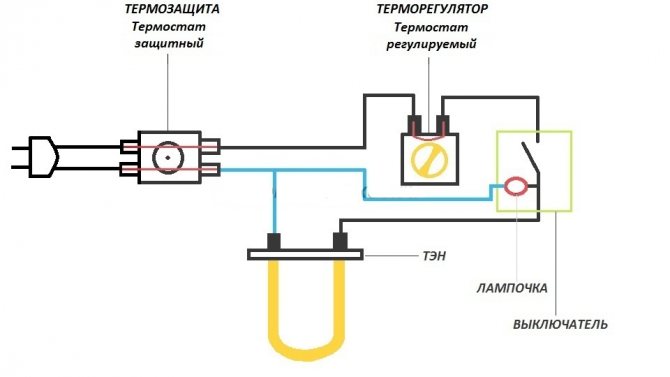
Diagram of an electric instantaneous water heater.
Flow-through devices for raising the temperature of hot water supply allow you to obtain a continuous and hot water flow. But there are serious restrictions. This equipment cannot be installed in ordinary housing, since full-fledged and productive devices have a power of about 20 kW and require a three-phase connection. Single-phase heaters with a power of 3-5 kW have poor performance and can provide heating within ∆t = 25-30°C, which will not create comfortable warmth when heating a cold stream with a temperature of 3-5°C. Powerful heating devices are recommended for houses, cottages, mini-hotels, the electrical wiring of which is designed for this power.
Advantages:
- creation of a continuous hot stream (with appropriate power);
- compactness.
Flaws:
- requires a three-phase connection to the network and electrical wiring of the required cross-section for the specified power of the device.
Gas devices
Gas flow equipment (columns) allows you to obtain the hot water temperature within almost any range and in any quantity, due to the heating of the water flow passing through a copper heat exchanger by a gas burner. The power of geysers is 15-25 kW.
Restrictions for use may include residential buildings that are not equipped with chimneys for such equipment. Nevertheless, the old housing stock was equipped with gas heaters. These devices with modern technical solutions can very accurately regulate the set temperature, regardless of the speed of water flow. This technology is carried out using flame modulation (changing its intensity, depending on the flow).
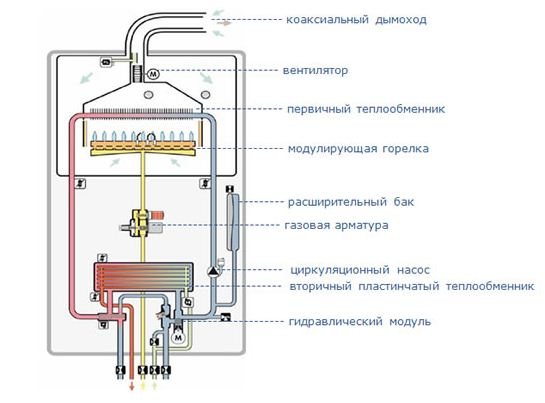
Diagram of a wall-mounted gas heater.
When a project is drawn up and approved by the relevant services, it is possible to install gas heaters in apartment buildings. In this case, devices with a closed type of burner are often used, which isolates the combustion chamber from the room. The intake of air and the emission of flue gases is carried out forcibly through a separately made chimney opening.
Advantages:
- high temperature delta heating;
- streaming mode;
- relative accuracy of the temperature at the outlet of the device.
Flaws:
- requires the availability of natural gas;
- technical conditions for installation and operation are required;
- Installation in bathrooms is prohibited.
Accidents and other situations
Within the cold water supply there are problematic cases associated with exceeding the temperature values in the supply system. Difficulties are actualized depending on the typical features of communications and the time of year.
The fact of slight warming is indicated by a change in the indicator by 6-9 degrees . Higher fluctuations are found in devices for autonomous supply of private houses.
If a change in heat is observed in multi-apartment residential buildings with a centralized hot and cold supply system, then the problem of mixing flows arises as a result of uneven pressure inside the pipe.
Read the Rules for paying housing and communal services using a personal account
Emergency situations:
- failure of a standard mixer that was previously installed on a riser intended for distributing water flows;
- gross errors related to supply - as a result of violations in the implementation of sanitary and technical measures in the basement;
- release of hot liquid into the cold supply lines;
- failure of washing machines;
- breakdown of equipment intended for washing and cleaning dishes;
- damage to other household appliances connected to the cold water system.
Any malfunctions associated with short-term emissions of hot flows into pipes with cold ones must be eliminated as soon as possible.
To minimize the risks associated with warming cold water during the operation of electrical heating appliances, it is necessary to immediately cut off the hot supply circuits while using specialized elements. Additionally, the boiler installation is disconnected from the common riser.
The presence of a pair of open circuits causes the mixing of masses of different temperatures, which automatically provokes a strong water hammer. The result is damage to plumbing parts.
Overheating and shutdown of burners in emergency mode occurs when using flow-type gas heating devices. An acceptable temperature is set by changing the current heating level on the profile device itself.
Double-circuit heating boiler
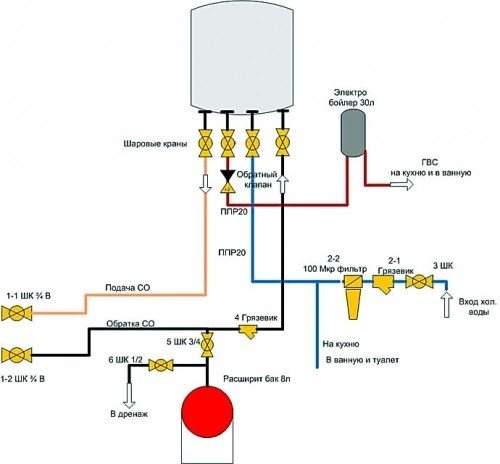
Connection diagram for a double-circuit boiler with a storage boiler.
In private housing construction and apartment buildings designed to operate autonomous heating sources, double-circuit mounted boilers are widely used. Hot water is produced in a secondary heat exchanger, which transfers heat from the heating system fluid to running tap water. As a result, water with the required temperature is formed at the outlet. The technical conditions for the operation of such devices correspond to the conditions for the use of flow-type gas heaters.
Advantages:
- temperature accuracy;
- streaming mode of operation.
Flaws:
- availability of technical conditions for installation;
- heating delta is lower than that of columns;
- inertia at work;
- rare cases of installation possibility in modern apartment buildings.
What temperature should cold water in the tap be according to GOST 2018?
This temperature is measured directly at an open tap by immersing a water thermometer in a glass under running water to a special mark. In accordance with Appendix No. 1 to the Rules, hot water supply must be uninterrupted and around the clock throughout the year. Permissible duration of hot water supply interruption: 8 hours (in total) for 1 month, 4 hours at a time, in case of an accident on a dead-end main - 24 hours in a row; The duration of interruptions in hot water supply in connection with annual repair and maintenance work in centralized networks of engineering and technical support for hot water supply is carried out in accordance with the requirements of the legislation of the Russian Federation on technical regulation (SanPiN 2.1.4.2496-09).
Alternative sources
There are methods of heating water using solar energy and heat pumps. The first method involves converting solar energy into thermal energy using special tower and mirror installations. Currently, it is not distributed in the CIS countries.
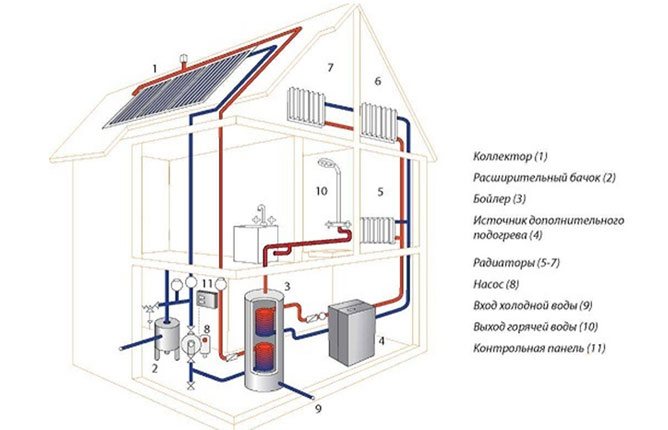
DHW from a boiler with an external boiler.
The second method involves the use of heat pumps operating on the principle of a refrigeration machine. Heat is taken from the air and transferred in special heat exchangers to the DHW circuit. This method is cost-effective, but has limitations:
- cannot be used at sub-zero temperatures;
- the water temperature in the hot water system is no more than 50°C.
Separately, it is necessary to say about cavitation water heating systems. The essence of their work is based on the passage of a liquid flow through a vortex cavitator, as a result of which it is heated. This method is economical compared to traditional thermal heating of liquid. It has been empirically proven that to heat the same volume of water to a certain ∆t using the cavitation method and the classical thermal method, different amounts of energy are expended. In the first option, 1 kW is spent to rotate the cavitator, and in the second option, 1.7 kW is spent to operate the heating elements.
Today, the method has gained little popularity, as it is not without a number of disadvantages, such as:
- limited heating temperature;
- noise of the engine and cavitator;
- A small amount of special equipment is produced.
Application of thermostatic mixers
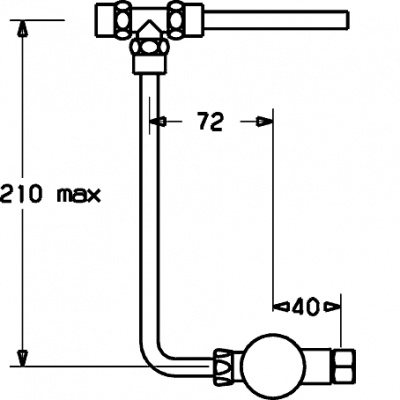
Thermostatic mixer.
Thermostatic faucets are available to precisely regulate the temperature supplied from the water tap.
The required heat and pressure value are set on the mixer handle.
As a result of further operation of such a mixer, the temperature regime remains the same even with minor changes in the water supply network.
It is clear that this value cannot be higher than the maximum heat of the supplied water from the hot water supply.
The operating principle is based on the opening and closing of a mixing valve controlled by a bimetallic head that responds to the temperature of the liquid.
Emergency situations associated with changes in tap water temperature
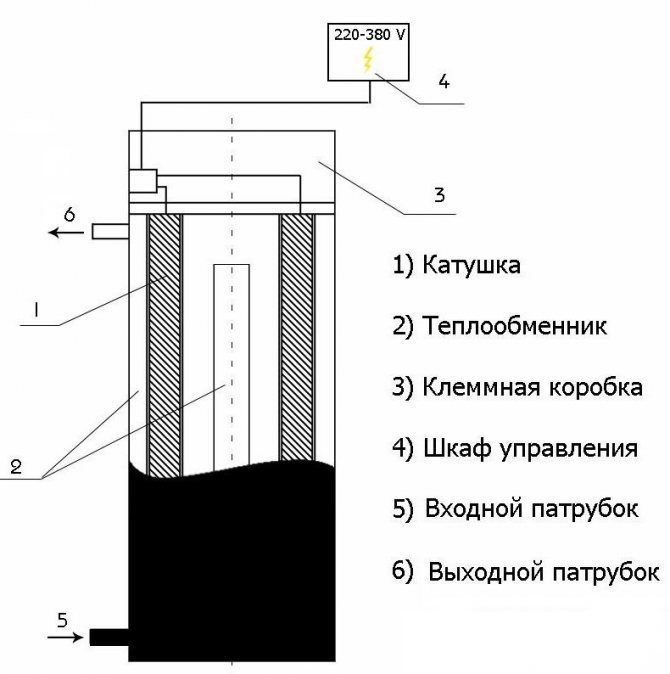
Diagram of an induction boiler for heating water.
There are problems associated with an unjustified increase in the temperature of cold water in the water supply. Moreover, a similar effect can occur at any time of the year. Sometimes cold water warms up slightly, by 5-10°C, but in some cases a noticeable warming of the water supply may be observed.
As a rule, such situations arise in multi-storey residential buildings with centralized hot water supply. Mixing of the aqueous media of hot and cold pipelines occurs, especially if the pressure in the hot pipeline is significantly higher than the pressure in the cold pipeline.
The reason, in most cases, is caused by a malfunction of the mixer on the distribution riser. Less common are errors in plumbing work carried out by plumbers in the technical underground, which causes the DHW medium to enter the cold main.
The described supply fault must be corrected within a short period of time. Warm water entering appliances such as automatic washing machines and dishwashers can damage the control electronics, and extremely hot water entering the flush cistern and then into the toilet sometimes causes it to crack due to sudden temperature changes.
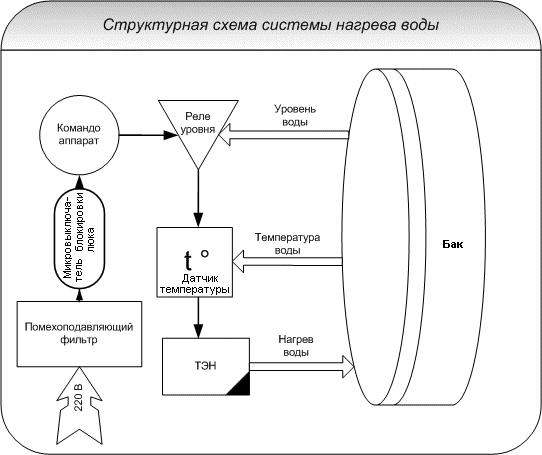
Block diagram of a water heating system.
If you install an electric water heater in an apartment and continue to use the central hot water supply as needed, it is necessary to cut off the hot water supply circuit when using the heater and cut off the boiler when drawing water from the riser.
If two circuits are open, mixing will occur and, in the worst case, a water hammer may occur, which will lead to the destruction of plumbing fixtures or components.
The operation of a gas instantaneous water heater involves operation without mixing cold water. That is, the temperature is set by changing the degree of heating directly on the gas equipment.
In exceptional cases, mixing is allowed, only in the case of a cold main supply to the heater as a separate branch through the manifold at the entrance to the apartment. Neglecting this recommendation may result in a decrease in water flow through the device’s heat exchanger, which will lead to overheating and emergency shutdown of the burners.
Temperature of cold water in the tap according to SNIP standard 2020
An increase in temperature up to 76% is considered a violation. Just like its drop to 56 degrees during the day or to 54% at night. How to measure your own temperature If a citizen thinks that the temperature of the hot water in the tap is much hotter than usual, then you should measure it according to all the rules. Demands can be made to the service organization only when measurements are taken in accordance with all the rules with the minimum permissible error. The thermometer must be in working order and contain a 100 degree scale. The algorithm of actions should be as follows:
- Open the hot water tap, while keeping the cold water closed. The water should drain within 3 minutes. Stagnant water is usually a little lower, so it should come off.
- Place a container, preferably at least a liter in volume, under running water.
- Without moving the container, take a measurement directly under running water.
No more than 8 hours at a time at a room temperature of 10 to 12 degrees, no more than 4 hours at a room temperature of 8 to 10 degrees. For every hour exceeding the specified standards, the monthly heating fee is reduced by 0.15%.
- How to measure.
- Emergency situations.
- Important details.
- Acceptable values Typically, the water supplied to residential private and apartment buildings is meant to be drinking water. What does the use of a specific SNiP mean? It is also important to note that in some cases deviations from established standards are allowed. Such cases today include primarily the following:
- for some reason it is not possible to provide the population with water in the usual way;
- there is agreement with special government bodies regarding the deviation;
- there is no threat to the population - in the presence of deviations from established standards;
- all necessary information regarding deviations from the norms is provided to the population itself.
According to established rules, the temperature of cold water should be no more than 20 0C.
If the temperature does not reach 40 degrees, payment must be made at the cost of cold water. The algorithm for calculating the coefficient if the norm is violated is as follows: Every three degrees below the norm gives an hourly reduction in the tariff by 0.1%.
Hot water does not meet the standard Where to complain The main question that worries residents of apartment buildings if the hot water does not meet the standard - Where to complain? According to the established rule, you must initially call the housing and communal services or management service. You should explain your situation to the dispatcher or service worker.
Remember ordinary village wells, in which the water is approximately equally cold in winter and summer, although the wells are somewhat more dependent on the time of year. By the way, this temperature underground remains to a depth of several hundred meters, and then it begins to rise. It is difficult to say what the temperature of cold water in the water supply is.
For example, at our work, cold water comes out of the tap in winter with warm water (36 -37 degrees), since the pipes run next to the heating ones. And at home, the temperature of cold water from the tap is 10 degrees (underground well). In comfortable apartments in big cities, cold water from the tap flows 15 - 20 degrees.
The temperature of hot water depends on both the type of water supply system and the time of day. At night, a temperature drop of 2 degrees lower than during the day is permissible. Temperature standards Standards for all indicators in the apartment must comply with SanPiN (sanitary rules and regulations) and GOSTs. SanPiN regulations for hot water have not changed in 2020.
These standards are adopted for reasons of expediency, since too cold or hot water can harm human health. Citizens pay not only for water delivery, but also for amenities associated with a certain temperature.
The water temperature directly depends on the type of water supply. Simply, cold and hot water must be at a certain temperature.
- There can be no clear answer to this question. The temperature of cold water in the tap can vary from approximately +10C to +20-25C. The water temperature depends on the depth of the well, the time of year, and how strong the water flow is. Typically, the water that flows as soon as we open the tap is slightly below room temperature, and the more water that flows, the colder it will be.
- In different ways, there is no standard for it, unlike hot water. You yourself understand that everything depends on the time of year and the ambient temperature - in the summer, sometimes you can take a shower with barely a single tap with cold water
- It is difficult to say what temperature the cold water in the water supply is. For example, at our work, cold water from the tap comes out of the tap in winter (36 -37 degrees), since the pipes run next to the heating pipes.
These sanitary rules are mandatory for all legal entities and individual entrepreneurs whose activities are related to the organization and (or) provision of centralized hot water supply systems... 2. General provisions…2.3. Sanitary and epidemiological requirements for centralized hot water supply systems are aimed at: - preventing contamination of hot water with highly contagious infectious pathogens of viral and bacterial origin that can reproduce at temperatures below 60 degrees, including Legionella Pneumophila;... 2.4.
The temperature of hot water at water collection points, regardless of the heat supply system used, must be no lower than 60 C and no higher than 75 C. 3. Requirements for the design, construction, and operation of centralized hot water supply systems 3.1.10.
This indicator is characterized by a minimum (not lower than 60 °C) and a maximum limit (not higher than 75 °C) and does not allow deviations from the specified temperature regime, subject to which the quality of the utility service is ensured.” The temperature of hot water in water collection points, regardless of the heat supply system used, must be no lower than 60 C and no higher than 75 C. REASONS: clause 5.1.2 SP 30.13330.2012 “Internal water supply and sewerage of buildings” Updated version of SNiP 2.04.01-85* ; P.
This is interesting: How to refuse major renovations in 2020
Cold water supply is a set of measures that are aimed at providing consumers with water in the required volume. Today, a person’s country stay in a private household can be just as comfortable as in a city apartment.
One of the main components of comfortable living is the availability of high-quality engineering communications, including a water supply system. Currently, such systems must comply with all established regulations and sanitary standards.
A standard urban plumbing system is represented by:
- a pipeline consisting of risers and supply pipes;
- the entrance of supply pipes into the building;
- valves of shut-off, mixing, regulating and water-folding types;
- water metering units;
- filtration devices;
- pumping equipment.
In private households, it is also possible to provide yourself with water by installing your own autonomous water supply system, presented by:
- installation of pumping equipment for a water intake source in the form of a well or borehole;
- installation of a water tank designed to ensure uninterrupted water supply and reduce the load on pumping equipment;
- arrangement of a water treatment system, including filter components and softeners;
- installation of piping inside the house.
The cold water supply standards specified in CHiP stipulate the supply of drinking cold water through pipelines that are made of materials that fully comply with sanitary standards. Most often, a pipeline made of modern and durable polypropylene or metal-plastic is used.
The temperature of the water in the system may also vary slightly depending on pressure indicators and quality composition.
According to the technical regulations specified in CHiP, a total interruption in the supply of cold water supply is allowed for no more than eight hours over the course of one month, as well as four hours at a time.
The amount of heat in the water supplied by the cold main is not decisive in assessing the comfort of living and in creating sanitary conditions.
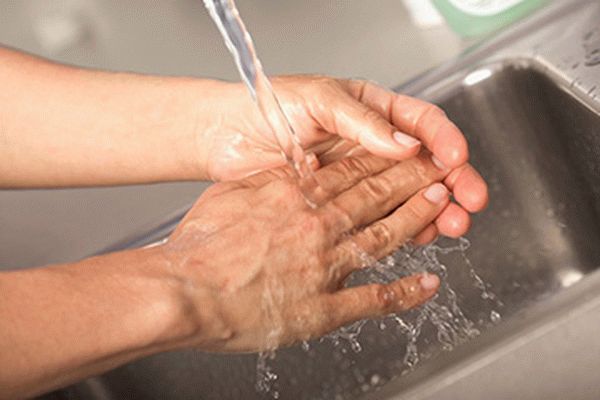
The qualitative composition of all water used for household and drinking needs must fully comply with the current State Standard, and for production purposes it is regulated by technological requirements.
The temperature regime of cold water in the GOCT tap is not regulated, but you need to remember that these indicators directly depend on the time of year.
This feature is associated with the temperature of the water at the source of water intake, as well as the temperature indicators of the soil at the level of the water pipeline.
In the main water supply, the water temperature can even be negative, since under conditions of high pressure inside the system, the process of freezing the liquid is noticeably slowed down.
It should be noted that in residential buildings and industrial facilities, where it is not possible to fully meet the needs of all consumers through sources of drinking water supply, the presence of technical and economic feasibility, as well as approvals from the SES, makes it possible to supply non-drinking water to premises with some basic plumbing fixtures.
Despite the fact that temperature standards for cold tap water are not provided for by regulations, local recommendations of service organizations often set parameters within 4-20 o C.
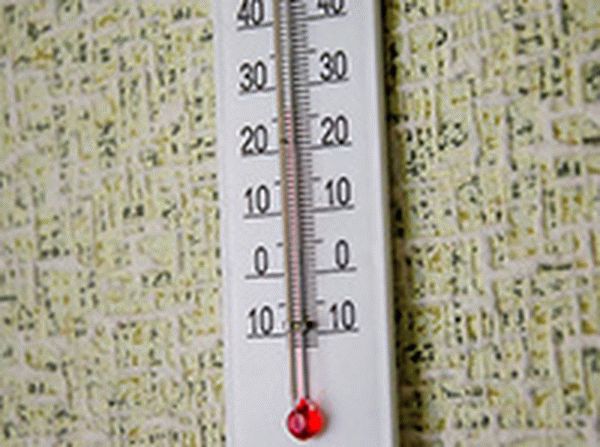
In winter, some apartments can be extremely hot, while others, on the contrary, are very fresh. The temperature standard in the apartment during the heating season must be regulated by the management company.
Kitchen flooring options are presented in this review.
If you have started a renovation, you cannot do without calculating the square meters of the room. You will learn how to correctly calculate the square footage of a room in this article.
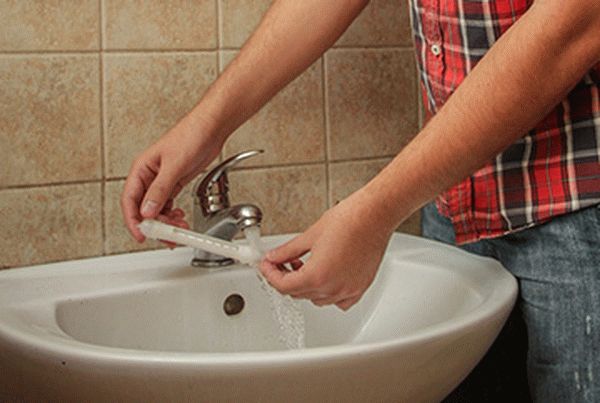
There are a number of basic and common problems that are directly related to exceeding the temperature of cold water in water supply systems.
Such problems arise regardless of the time of year and typical features of the water pipeline.
A slight warming of water is characterized by an increase in temperature indicators of only 6-10°C, but more pronounced fluctuations occur quite often not only in conditions of autonomous water supply to the private residential sector.
If warming of cold water coming from the tap occurs in a multi-apartment residential building with a centralized hot water supply, then we can assume the problem of mixing hot and cold water media under conditions of unequal pressure inside the pipelines. As a rule, the main reason for such mixing is a malfunction of the standard mixer installed on the distribution riser.
Somewhat less often, the mixing of aqueous media is the result of gross errors made in the process of performing basic sanitary and technical work in the technical underground, which causes hot water to be thrown into the cold main.
It is important to remember that any problems accompanied by even short-term injection of hot water into the cold water supply system must be eliminated as soon as possible. Otherwise, expensive automatic washing machines and dishwashing equipment, as well as many other household appliances operating using a cold water supply system, will fail.
To prevent warming of cold water in the tap when operating any electric water heating devices, it is necessary to promptly cut off the hot water supply circuit while using the heating element, as well as cut off boiler devices in conditions of water intake from the common riser.
The presence of two open circuits most often causes mixing of hot and cold environments, and also provokes the occurrence of powerful water hammer, and, as a result, breakdown of plumbing.
The use of flow-type gas water heating devices for hot water supply is based on the operation of the unit without adding cold water, and the temperature indicators of the water supplied to the tap should be set only by changing the heating level on the equipment itself. Otherwise, overheating and subsequent shutdown of the burners in emergency mode occurs.

GOST and SanPin set the standard temperature in the apartment. But there are certain factors that influence its change. Let's talk about them in more detail.
This is interesting: The statute of limitations for contributions for major repairs is 2020
Is it worth installing an individual heat meter in an apartment? We’ll figure it out further.
That is why, at the first sign of hot water being thrown into the cold main, it is necessary to carry out the full scope of repair or basic preventive work as quickly as possible.
The use of public services today is regulated by special legal norms. First of all, this is the Housing Code of the Russian Federation. It should be noted that the legislation establishes not only the characteristics of hot water, but also cold water.
The use of public services today is regulated by special legal norms. It should be noted that the delivery must be carried out in accordance with the standards established by law.
First of all, this concerns the parameters of hot and cold water. The requirements for the delivery mode must be met.
A specific mode is set for cold and hot water. Moreover, most often difficulties arise due to hot temperatures. Cold water supply, as a rule, does not cause any complaints in most cases.
Cold water supply refers to a number of special standards aimed at providing ordinary citizens with water. One of the most important points that directly affects the quality of supplied water is engineering communications.
For 2020, the cold water supply system includes the following:
- the pipeline itself – through which delivery is carried out to an apartment or household;
- pipe entrance, supply to the building;
- various types of fittings - shut-off, mixing, etc.;
- water meter units;
- all kinds of water filtration devices;
- pump equipment.
Moreover, the longer the path the water travels, the higher the likelihood that it will not comply with certain standards established by law.
Since today there are many nodes in the water supply system where the initial parameters are changed. There is a special SNiP according to which drinking and other water is supplied.
This document determines the quality of such water, as well as its temperature. It may vary slightly depending on pressure and some other important factors. Legislation and various regulations also determine the cold water supply mode. According to the standards, the break should not be more than 8 hours in a row.
For 2020, this legislative document includes the following:
Chapter No. 5 defines all issues related to state control in the supply of relevant housing and communal services. The number of water samples per month and other standards are indicated.
It is worth noting that controversial or conflict situations that often arise in the housing and communal services sector are best resolved peacefully. Since legal proceedings take a lot of time, they require some expenses. If for some reason it is not possible to resolve the situation peacefully, then the best solution would be to go to court.
There are also state city special services that monitor this area. By contacting them, it will be possible to influence public services that deal with the issue of supplying cold water and other public services.
It is important to first study all the main regulatory documents. Often, a case is refused due to the lack of properly executed documents.
The temperature of cold water in the tap in winter, for natural reasons, will be slightly lower than that supplied in summer. The supply of utilities is regulated using heat meters, as well as many other special devices.
It will be necessary to remember that the water supply process is determined by the standards not only for apartment buildings, but also for private households. It is very important to remember that there are quite a few different special rules.
The main issues that are best studied in advance include:
- Valid values.
- Standard according to GOST.
- How to measure.
- Emergency situations.
- Important details.
Typically, the water supplied to residential private and apartment buildings means drinking water. What does the use of a specific SNiP mean? It is also important to note that in some cases deviations from established standards are allowed.
Such cases today include primarily the following:
- for some reason it is not possible to provide the population with water in the usual way;
- there is agreement with special government bodies regarding the deviation;
- there is no threat to the population - in the presence of deviations from established standards;
- all necessary information regarding deviations from the norms is provided to the population itself.
According to established rules, the temperature of cold water should be no more than 20 0C. There are no alternative requirements for maximum cold water performance. It is important to familiarize yourself in advance with all the subtleties and standards for using this type of water.
There is a special legal norm that defines all the main points regarding the use of cold water. Moreover, in the case of hot water, everything is much stricter and more serious. Since if the hot temperature is lower than the standard specified above, then the consumer has the right to pay as for cold.
You can measure the main indicators of water yourself. But to contact the relevant authorities and accept the application, you must contact the City Housing Supervision Authority.
This body carries out the process of checking all the necessary data; specialists will test the water on site. It is important to note that this process usually occurs during the day, on a weekday. Which is often quite problematic for ordinary citizens.
If emergency situations occur, water may be turned off or may not meet the requirements to some extent. But it should be noted that in this case, only 45 days are provided for troubleshooting. During which time it must be corrected. A complete shutdown of water is possible only for 8 hours in a row, no more.
Video: measurement
It is important to note that the process of measuring water parameters must be accurate and not subjective. Also, to file a complaint with the appropriate authorities, you will need to prepare documentary evidence, an application drawn up in the prescribed form.
This is interesting: At whose expense is the installation of common house metering devices carried out? 2020
Every year the various services work more and more coherently. Therefore, if violations occur, it is necessary to immediately record this moment.
Separately, it should be noted that knowledge of the legislation will allow you to avoid many problems and difficulties. – related to the analysis of supplied utilities. This will allow you to independently resolve most of the various complex situations, including those with parameter matching.
- Due to frequent changes in legislation, information sometimes becomes outdated faster than we can update it on the website.
- All cases are very individual and depend on many factors. Basic information does not guarantee a solution to your specific problems.
That's why FREE expert consultants work for you around the clock!
APPLICATIONS AND CALLS ARE ACCEPTED 24/7 and 7 days a week.

The temperature of cold water in the tap of a central urban or rural water supply can depend on many factors.
Hello, dear portal visitor! Unfortunately, the article reveals only a typical answer to the question you are interested in. To consider a specific problem, write it to us online consultant
.
One of our lawyers immediately and completely free of charge
.
The physical parameters of water are also influenced by the technical characteristics of the entire system, which vary depending on the installation method and location.
The city water supply system consists of:
- Pipeline, it consists of risers and conductive pipes.
- Entrance of conductive pipes into the house.
- Certain types of fittings (water intake, mixing, shut-off, control).
- Water meter units.
- Pumps.
- Filters of various types (reverse osmosis, cartridge, flow, jug).
In private households, the water supply system is presented differently:
- Well, well, water tower.
- Pump.
- A container for permanent storage of liquid, this will ensure uninterrupted supply and allow the pump to last longer.
- Various filters for cleaning.
- Piping.
According to the standards, the physical parameters of cold water in the tap are acceptable within 4-20⁰C. These standards should be established by housing and communal services or other local authorities; all standards are only recommendations. Exact indicators for 2020 have not been established, since they may change according to SanPin 2.1.4.1074.1 and SNiP 2.04.01-85 standards depending on the time of year and place of residence. Thus, the degree of warmth of water in autumn can be 10⁰ C in September, and 5-6⁰ in October. In fact, the approximate temperature is 9 degrees. If water is supplied by a private company, then the heat is set according to their regulations within the recommended values.
You can independently find out the temperature of the water in your apartment, it should be 9⁰ C. For an accurate measurement, take 2 containers, one larger and the other smaller, but higher. Pour cold water into a large container and place it on the bottom of the sink, then collect the liquid in a small container and place it in a larger one so that the stream flows into the larger container and does not fall into the smaller container. Then place the thermometer in a smaller container and wait 5 minutes.
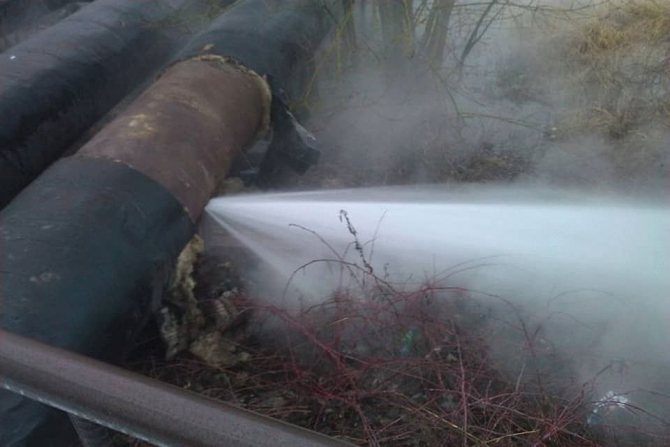
In various emergency situations, the degree of water heat may change. The origin of the problems is not related to the place of residence or the time of year. If the temperature increase occurs by 6-10 degrees, it is considered insignificant and caused by natural factors or accident (error at the water utility station, passage of pipes in warming zones). In private households, even significant warming is most often associated with natural factors.
- If the warming is significant and occurs in an apartment building, then this indicates mixing of hot and cold liquids. Such mixing can take place at the level of the water utility, your water supply unit or in your tap.
- If the mixing occurs in the water utility, then you should call them and report the problems, after which they will call you back and perhaps tell you that the problem is not with them, but with you.
- If there is a problem at the node level, then the water utility specialists will solve this problem for a short time by turning off the water.
- If mixing occurs in your tap, then you should call a plumber who will fix the problem.
Remember that any mixing of water leads to breakdown of equipment or a decrease in its quality that is connected to the water supply system, namely:
- Washing machines.
- Dishwashers.
- Filters.
- Faucets.
- Various water heaters and boiler devices.
- Therefore, you need to urgently contact one of the services and take action.
To avoid cold water warming and getting into electrical appliances, you should promptly cut off the hot water supply circuit and cut off devices if they are connected to a common riser.
The presence of two open circuits leads to mixing of different media, resulting in an increase in pressure and pressure, which is why equipment breaks down.
Too low heat of the liquid is also harmful both to health and to plumbing; a sharp decrease in the degree of heat is caused only by natural factors, for example, a sharp cold snap or a decrease in the depth of the reservoir.
In conclusion, we can say that a slight increase or decrease in the warmth of the environment will have virtually no effect on the comfort of living; significant changes in amplitude can lead to serious problems associated with the breakdown of electrical equipment and deterioration of living conditions. Therefore, if you observe changes, you should contact special services and fix the problem.
»
Other
HOA Audit Commission: rights and responsibilities 2020
Read more
Other
Unauthorized connection to power grids: fine and liability 2020
Read more
Other
Series and number of the certificate of registration of ownership of the apartment: how to find out 2020
Read more
Other
Special invoice for major repairs of an apartment building in 2020
Read more
Other
The limitation period for contributions for major repairs is 2020
Read more
Great article 0

